 WAP did join a digital conference, set by “Future Project”, “Cervignano Nostra” and “Adri-Antartica”, held on Saturday June 6th, to promote and enhance a site called “Antarctic Memorial” being born in Cervignano, a city in Northern Italy near Trieste.
WAP did join a digital conference, set by “Future Project”, “Cervignano Nostra” and “Adri-Antartica”, held on Saturday June 6th, to promote and enhance a site called “Antarctic Memorial” being born in Cervignano, a city in Northern Italy near Trieste.
Pic aside shows the participants:
Luca Furios (Moderator)
Luca Palazzi (Student and maker of the scale model of the G.Bove base)
Prof PH D Julius Fabbri (IV3CCT)
Maria Teresa Scarrone President & Salvatore Puro Vice President (Associazione Culturale Giacomo Bove e Maranzana)
Carlos Pedro Vairo (Director of Marine and Antarctic Museum-Ushuaia, TdF, Argentina)
Gianni Varetto I1HYW (WAP)
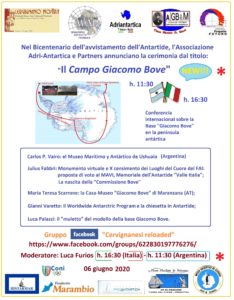 We are talking about a place (MAVI) entering in a challenge launched by FAI (Fondo Ambiente Italiano). Since 1975, FAI – Fondo Ambiente Italiano, the National Trust for Italy, restores and takes care of special places in Italy so that present and future generations from all over the world, may enjoy a priceless legacy.
We are talking about a place (MAVI) entering in a challenge launched by FAI (Fondo Ambiente Italiano). Since 1975, FAI – Fondo Ambiente Italiano, the National Trust for Italy, restores and takes care of special places in Italy so that present and future generations from all over the world, may enjoy a priceless legacy.
We already reported about this subject, but for those who wish to refresh their memory, here below are the links:
http://www.waponline.it/april-18th-2020-international-day-for-monuments-and-sites/ and http://www.waponline.it/the-giacomo-bove-antarctic-base-relives-in-italy-thanks-to-the-students/ .
Hereby a bit of the story:
In 1976 the film entrepreneur Renato Cèpparo, born in Portogruaro Italy, but lived in Milan, inaugurated the first Italian scientific research Base at Italian Valley, on King George island, Antarctica and named it to Giacomo Bove (WAP ITA-Ø2). After only 8 (eight) months, the base was dismantled by a group of 30 sailors from the Argentine Navy. That has caused a diplomatic happening and the case… a classic “cold case” is still open
Despite the initial support of the Argentines and the Italian institutions (CNR, Foreign Ministers, Universities, etc.), the entrepreneur was soon “discharged” and began his “ban”, a modern example of “damnatio memoriae” that, nowaday, is still on!
Forty years later, an high school teacher, prof. Julius Fabbri, after having been in Antarctica in front of King George Island, decided to build a memorial to recall the ” Giacomo Bove Camp“, which had been so named in memory of the homonymous hydrographer, officer of the marine direction Giacomo Bove (23 april 1852 – 09 august 1887), the greatest Italian explorer of the nineteenth century.
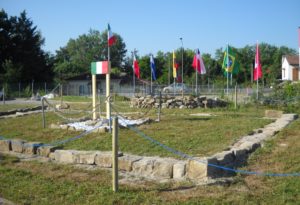 The “Valle Italia” Antarctic Memorial, Cèpparo-Bove (MAVI) was inaugurated in 2018, at the IISS Arturo Malignani of the Bassa Friulana, a UNESCO associated school.
The “Valle Italia” Antarctic Memorial, Cèpparo-Bove (MAVI) was inaugurated in 2018, at the IISS Arturo Malignani of the Bassa Friulana, a UNESCO associated school.
Beside the MAVI construction site, Prof. Julius Fabbri carries out the diplomatic project of “Establishment of the First Italian Antarctic Historical Site” (IPSSIA) with the Ministry of Foreign Affairs. This year In fact, the MAECI should have presented an article with a paragraph on MAVI, but unfortunately Covid19 had the event canceled.
The actual conference has been organized to document what has been done so far, and the Organizations that share and support the project.
The whole activities are coordinated by prof. Fabbri who founded the Adri-Antartica Association, together with national consortium set up to follow the various phases, together with the local committee “ItalyAntartide” of Cervignano del Friuli.
Among the dozens of supporters, there is “Giacomo Bove & Maranzana Association” the historical partner of the project (see http://www.giacomobove.it/ita/) .
The new visitor center called Antarctic Memorial “Valle Italia” (MAVI), Cepparo-Bove is available at IISS Arturo Malignani, Cervignano del Friuli, Italy.
Live stream video of the conference, is available on facebook at:
https://www.facebook.com/luca.furios/videos/10218089372407078/UzpfSTE2MjAwODM3ODY6MTAyMjA5MDIxMzg0OTYxMjc/
TNX Julius IV3CCT /II3BOVE, WAP-271.
(New callsign of the “Malignani 2000” School is IV3HIY , the project manager is OM Julius Fabbri, IV3CCT with the help of ARI Udine-Italian Amateur Radio Association).
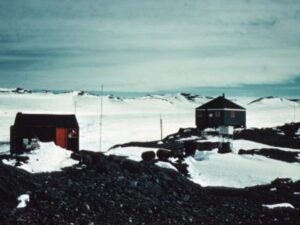 It was the location of the British research Station “V”, which was active intermittently from June 3, 1953 to November 25, 1963 and called Seal-catcher’s Arms or View Point Hut, with the intention of searching in the survey, meteorology and geology. Established as a satellite base for Hope Bay (Station D) WAP GBR-Ø4 , the construction of the first hut started on June 3, 1953, the second was established on March 20, 1956.
It was the location of the British research Station “V”, which was active intermittently from June 3, 1953 to November 25, 1963 and called Seal-catcher’s Arms or View Point Hut, with the intention of searching in the survey, meteorology and geology. Established as a satellite base for Hope Bay (Station D) WAP GBR-Ø4 , the construction of the first hut started on June 3, 1953, the second was established on March 20, 1956.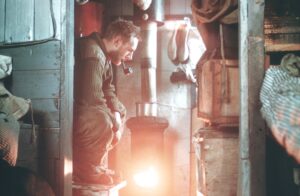

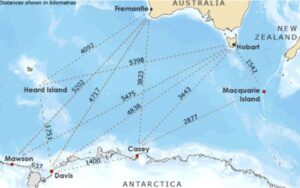 The battle to keep Antarctica free of coronavirus will see Australian expeditioners spend up to an extra four months on the ice-covered wilderness.
The battle to keep Antarctica free of coronavirus will see Australian expeditioners spend up to an extra four months on the ice-covered wilderness.
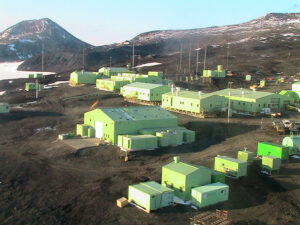 Donning a headset, people are invited to step inside Hillary’s Hut and to explore the first building at what is now New Zealand’s Scott Base (
Donning a headset, people are invited to step inside Hillary’s Hut and to explore the first building at what is now New Zealand’s Scott Base (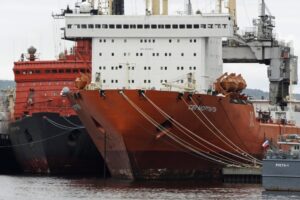
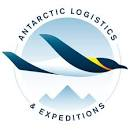 With more than 30 years of experience, ALE (
With more than 30 years of experience, ALE (
 NCPOR condoles the death of Dr. Vilas Jogdand, Leader of Maitri Station during the 35th Indian Scientific Expedition to Antarctica (2015-16).
NCPOR condoles the death of Dr. Vilas Jogdand, Leader of Maitri Station during the 35th Indian Scientific Expedition to Antarctica (2015-16). 2012-2013 and 2014-2015, respectively. He was the Leader of the expedition in 2015–2016.
2012-2013 and 2014-2015, respectively. He was the Leader of the expedition in 2015–2016.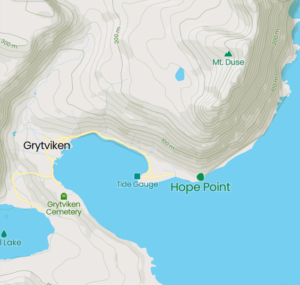 Hope Point, 54° 17′ South, 36° 29′ 15″ West, is a rocky bluff, 20 meters (70 ft) high, which forms the north side of the entrance to King Edward Cove.
Hope Point, 54° 17′ South, 36° 29′ 15″ West, is a rocky bluff, 20 meters (70 ft) high, which forms the north side of the entrance to King Edward Cove.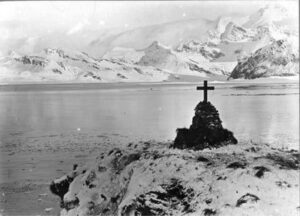 off on the expedition thinking the body was bound for England.
off on the expedition thinking the body was bound for England.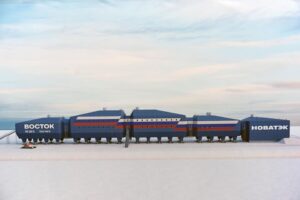 Reconstruction of the Vostok II Station, the only inland Antarctic station used by Russia, is scheduled to be completed by 2024.
Reconstruction of the Vostok II Station, the only inland Antarctic station used by Russia, is scheduled to be completed by 2024.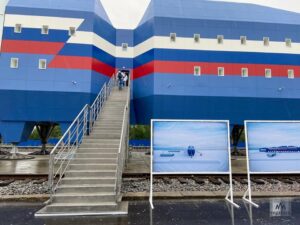
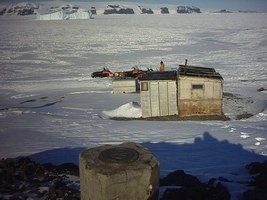 The Refuge, is one of the 18 shelters that are under the responsibility of Esperanza, which is responsible for the maintenance and the care. It has capacity for 12 people, food for two months, fuel, gas and first aid kit. It has been used in some Argentine scientific campaigns and ordinary patrolling. The main scientific observations are the geology and topography of the area, the sea ice and survey on the Crabeater seal and the Weddel seal.
The Refuge, is one of the 18 shelters that are under the responsibility of Esperanza, which is responsible for the maintenance and the care. It has capacity for 12 people, food for two months, fuel, gas and first aid kit. It has been used in some Argentine scientific campaigns and ordinary patrolling. The main scientific observations are the geology and topography of the area, the sea ice and survey on the Crabeater seal and the Weddel seal.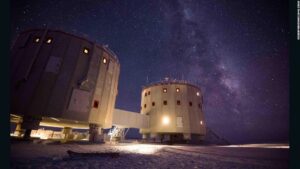 After four months of darkness, the sun finally rises on 11 August at Concordia Research Station (
After four months of darkness, the sun finally rises on 11 August at Concordia Research Station (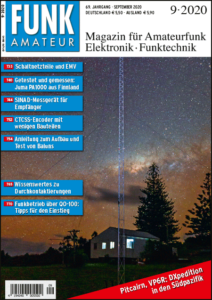 From page 789 and ahead, the newest Edition of the Funkamateur includes four Antarctic-related articles
From page 789 and ahead, the newest Edition of the Funkamateur includes four Antarctic-related articles Penguin populations are usually associated with the polar ice caps, most likely originating from Antarctica. A team of scientists from Berkley University of California has determined that penguins first lived in Australia and New Zealand nearly 22 million years ago.
Penguin populations are usually associated with the polar ice caps, most likely originating from Antarctica. A team of scientists from Berkley University of California has determined that penguins first lived in Australia and New Zealand nearly 22 million years ago. Blood and tissue samples allowed scientists to trace back how penguins became diverse throughout millions of years, and how they moved south to Antarctica. They believe that the emperor and king penguins left their ancestors and migrated to Antarctica due to the abundant supply of food available. These two specific penguin species have caused experts to debate about where they fit in the penguin family tree and are believed to belong to a ‘sister group
Blood and tissue samples allowed scientists to trace back how penguins became diverse throughout millions of years, and how they moved south to Antarctica. They believe that the emperor and king penguins left their ancestors and migrated to Antarctica due to the abundant supply of food available. These two specific penguin species have caused experts to debate about where they fit in the penguin family tree and are believed to belong to a ‘sister group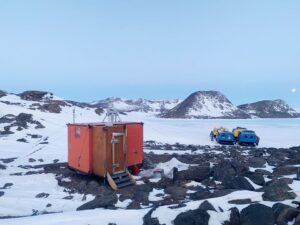 Mawson Base (WAP AUS-Ø4) and 5 km north-east of Taylor Glacier on an island in the Colbeck Archipelago. Established in 1988, it is used as shelter for visitors to the Taylor Glacier area, including to monitor the Taylor Glacier emperor penguin colony in ASPA 101. It can only be accessed over fast ice or via rotary wing aircraft. The refuge can accommodate four persons. It contains medical facilities such as comprehensive first aid kit, food and fuel for heating, lighting, and cooking (either kerosene or LPG)
Mawson Base (WAP AUS-Ø4) and 5 km north-east of Taylor Glacier on an island in the Colbeck Archipelago. Established in 1988, it is used as shelter for visitors to the Taylor Glacier area, including to monitor the Taylor Glacier emperor penguin colony in ASPA 101. It can only be accessed over fast ice or via rotary wing aircraft. The refuge can accommodate four persons. It contains medical facilities such as comprehensive first aid kit, food and fuel for heating, lighting, and cooking (either kerosene or LPG)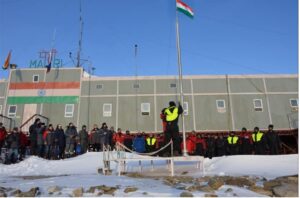 The 74th India Independence Day celebrations has been a great moment at Maitri Indian Research Base in Antarctica (WAP IND-Ø3).
The 74th India Independence Day celebrations has been a great moment at Maitri Indian Research Base in Antarctica (WAP IND-Ø3).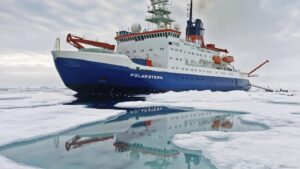 DPØPOL/mm is going to be active shortly. So far, the call sign has only been used on FT8 and PACTOR, so there is some real radio operation now!
DPØPOL/mm is going to be active shortly. So far, the call sign has only been used on FT8 and PACTOR, so there is some real radio operation now! Going back to Felix report, the Ham Radio Station is up and running, so Andreas, DL3LRM, will be active in CW signing DP0POL/MM on 40m, 30m, and 20m from various locations near the North Pole. QSL via DL5EBE
Going back to Felix report, the Ham Radio Station is up and running, so Andreas, DL3LRM, will be active in CW signing DP0POL/MM on 40m, 30m, and 20m from various locations near the North Pole. QSL via DL5EBE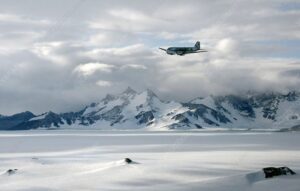
 Satellite observations have found a raft of new Emperor penguin breeding sites in the Antarctic. The locations were identified from the way the birds’ poo, or guano, had stained large patches of sea-ice.
Satellite observations have found a raft of new Emperor penguin breeding sites in the Antarctic. The locations were identified from the way the birds’ poo, or guano, had stained large patches of sea-ice.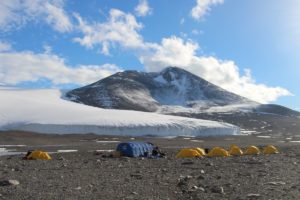 Field camp at Spaulding Pond, is located at 77° 39’ South, 163° 7’ East is a pond 0.3 nautical miles (0.6 km) northeast of the terminal ice cliff of Howard Glacier in Taylor Valley, Victoria Land, Antarctica.
Field camp at Spaulding Pond, is located at 77° 39’ South, 163° 7’ East is a pond 0.3 nautical miles (0.6 km) northeast of the terminal ice cliff of Howard Glacier in Taylor Valley, Victoria Land, Antarctica.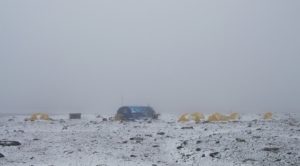 Spaulding Pond Field Camp, 77° 39’ South, 163° 7’ East, will be add to the
Spaulding Pond Field Camp, 77° 39’ South, 163° 7’ East, will be add to the 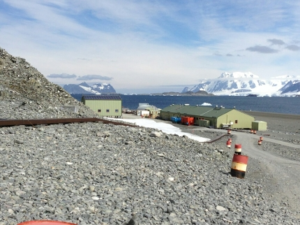 Dirck Gerritsz Laboratory (
Dirck Gerritsz Laboratory (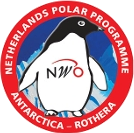 The Netherlands is a signatory to the Antarctic Treaty and has observer status on the Arctic Council. As a participant, the country undertakes to invest in research at the poles. This is the reason behind the Netherlands’ Polar Research Program.
The Netherlands is a signatory to the Antarctic Treaty and has observer status on the Arctic Council. As a participant, the country undertakes to invest in research at the poles. This is the reason behind the Netherlands’ Polar Research Program.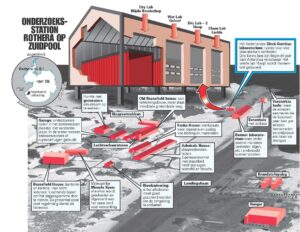 NWO and the Royal Netherlands Institute for Sea Research (NIOZ) developed a design for a laboratory in conjunction with BAS. An arrangement with four separate laboratories made from sea containers placed in a ‘docking station’ was chosen. It supplies the labs with electricity, Internet and water and protects them from the severe weather conditions. BAS built the docking station and NIOZ built the mobile laboratories, each with funding from the Netherlands Polar Program (NPP). Main science disciplines studied at Dirck Gerritsz Laboratory are:
NWO and the Royal Netherlands Institute for Sea Research (NIOZ) developed a design for a laboratory in conjunction with BAS. An arrangement with four separate laboratories made from sea containers placed in a ‘docking station’ was chosen. It supplies the labs with electricity, Internet and water and protects them from the severe weather conditions. BAS built the docking station and NIOZ built the mobile laboratories, each with funding from the Netherlands Polar Program (NPP). Main science disciplines studied at Dirck Gerritsz Laboratory are: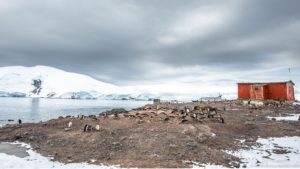 Refuge Caillet-Bois (WAP ARG-NEW) is an Argentine refuge in Antarctica located on D’Hainaut Island (63º54´00″ South , 60º47´00″ West). The refuge was inaugurated by the Argentine Navy on December 10th 1954. Originally it took the name of Refuge Port Mikkelsen referred to the name of the Danish arctic explorer Ejnar Mikkelsen. The refuge with its current name, which pays tribute to the Argentine naval Captain and historian Teodoro Caillet Bois,
Refuge Caillet-Bois (WAP ARG-NEW) is an Argentine refuge in Antarctica located on D’Hainaut Island (63º54´00″ South , 60º47´00″ West). The refuge was inaugurated by the Argentine Navy on December 10th 1954. Originally it took the name of Refuge Port Mikkelsen referred to the name of the Danish arctic explorer Ejnar Mikkelsen. The refuge with its current name, which pays tribute to the Argentine naval Captain and historian Teodoro Caillet Bois,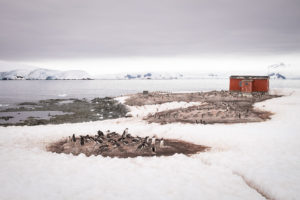 was given in December 1977 by the icebreaker ARA General San Martin (Q-4). Then it was closed and evacuated on January 17 of the following year by the icebreaker personnel.
was given in December 1977 by the icebreaker ARA General San Martin (Q-4). Then it was closed and evacuated on January 17 of the following year by the icebreaker personnel.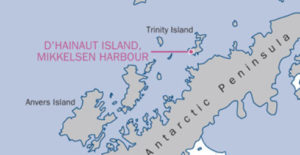 D’Hainaut Island is a small island largely flat, rocky island (less than 1 sq km), lying in Mikkelsen Harbour, a 3km wide bay, lined with ice cliffs, indenting the south side of Trinity Island between Skottsberg and Borge Point. The island is often snow covered until late in the season and there are a number of shallow reefs in the waters surrounding the island.
D’Hainaut Island is a small island largely flat, rocky island (less than 1 sq km), lying in Mikkelsen Harbour, a 3km wide bay, lined with ice cliffs, indenting the south side of Trinity Island between Skottsberg and Borge Point. The island is often snow covered until late in the season and there are a number of shallow reefs in the waters surrounding the island.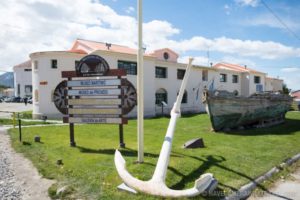 Ushuaia has grown by the sea but also under the watchful gaze of the prison. Both the Maritime, Antarctica and the Prison Museums bear witness to the passing of time in this southern land. While one tells the great adventures of seafarers, the other narrates the lives of those condemned to reclusion.
Ushuaia has grown by the sea but also under the watchful gaze of the prison. Both the Maritime, Antarctica and the Prison Museums bear witness to the passing of time in this southern land. While one tells the great adventures of seafarers, the other narrates the lives of those condemned to reclusion.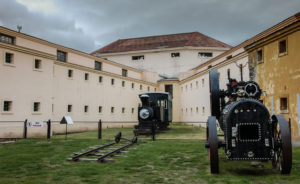
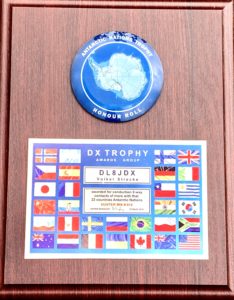 Two interesting Plaques for the Antarctic Trophies collectors!
Two interesting Plaques for the Antarctic Trophies collectors!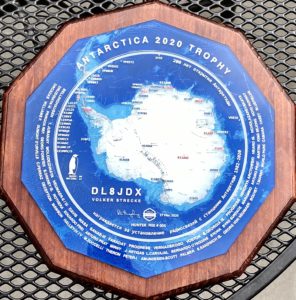 To get more on the Antarctica 2020 Trophy, issued to celebrate the 200 years of discovering Antarctica, see
To get more on the Antarctica 2020 Trophy, issued to celebrate the 200 years of discovering Antarctica, see 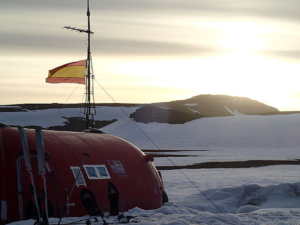 Camp Byers (Campamento Byers) is a Spanish seasonal base camp located at 62°39′49″South, 61°05′58″West on the south beaches of Byers Peninsula, in the western part of Livingston Island in the South Shetland Islands. The locality is also designated for use as an International Field Camp. When necessary for scientific research purposes, temporary camping is allowed elsewhere on the protected peninsula under certain conditions. The camp was installed to support the scientific research in the area during short periods of time. Due to the increasing interest in the area, the camp is still operative but can be easily dismantled when required. It is maintained by the personnel of Juan Carlos I station (WAP ESP-Ø1) who keep the camp in a good condition year by year. The camp consists in two fiber glass “melon huts” each of 6m x 2m in size, one set up for scientific research and the other for domestic activities. The camp is open to all the Parties.
Camp Byers (Campamento Byers) is a Spanish seasonal base camp located at 62°39′49″South, 61°05′58″West on the south beaches of Byers Peninsula, in the western part of Livingston Island in the South Shetland Islands. The locality is also designated for use as an International Field Camp. When necessary for scientific research purposes, temporary camping is allowed elsewhere on the protected peninsula under certain conditions. The camp was installed to support the scientific research in the area during short periods of time. Due to the increasing interest in the area, the camp is still operative but can be easily dismantled when required. It is maintained by the personnel of Juan Carlos I station (WAP ESP-Ø1) who keep the camp in a good condition year by year. The camp consists in two fiber glass “melon huts” each of 6m x 2m in size, one set up for scientific research and the other for domestic activities. The camp is open to all the Parties.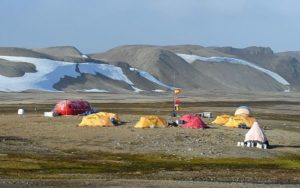 The main access is by ship or helicopter. Parties should liase with Spain, Spanish Polar Committee, to co-ordinate access to the melon huts.
The main access is by ship or helicopter. Parties should liase with Spain, Spanish Polar Committee, to co-ordinate access to the melon huts.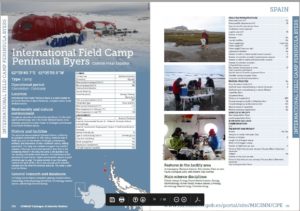 Antarctic biodiversity, and because of its high level of environmental protection, it has been very little affected by human activities. Finally, the proximity to the Spanish polar installations on Livingston Island and the experience derived from previous expeditions to the site make it logistically feasible as a site for ongoing monitoring and research.
Antarctic biodiversity, and because of its high level of environmental protection, it has been very little affected by human activities. Finally, the proximity to the Spanish polar installations on Livingston Island and the experience derived from previous expeditions to the site make it logistically feasible as a site for ongoing monitoring and research.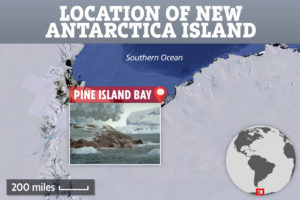 Sif Island is the name given to an island in of the Amundsen Sea, in Antarctica. It is 1,150 feet (350 m) long and made of volcanic granite. Scientists spotted this “uncharted island” earlier this year, but a NASA satellite has been tracking it since 2014, the United States Geological Survey (USGS) revealed.
Sif Island is the name given to an island in of the Amundsen Sea, in Antarctica. It is 1,150 feet (350 m) long and made of volcanic granite. Scientists spotted this “uncharted island” earlier this year, but a NASA satellite has been tracking it since 2014, the United States Geological Survey (USGS) revealed.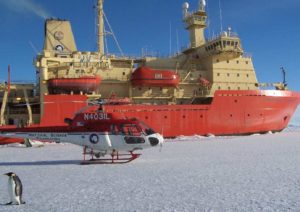 “I think I see rocks”, shouted an officer aboard the RV Nathaniel B. Palmer as the ship passed through Pine Island Bay, Antarctica. After consulting their charts, the crew realized they were looking at a brand-new island. There was a commotion as everyone onboard rushed to see the rocky, ice-covered
“I think I see rocks”, shouted an officer aboard the RV Nathaniel B. Palmer as the ship passed through Pine Island Bay, Antarctica. After consulting their charts, the crew realized they were looking at a brand-new island. There was a commotion as everyone onboard rushed to see the rocky, ice-covered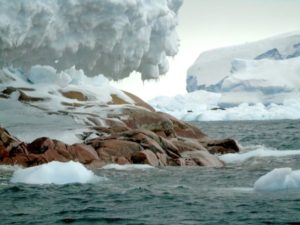 covered in ice, but rises from the sea with a layer of brown rock distinct from the surrounding glaciers and icebergs.
covered in ice, but rises from the sea with a layer of brown rock distinct from the surrounding glaciers and icebergs.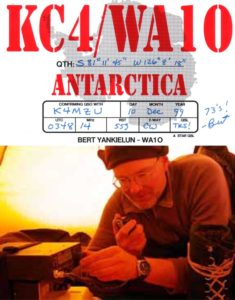 Norbert (Bert) E. Yankielun did operate on 1999 as KC4/WA1O from Temporary Byrd Surface Camp using 100w, battery powered, Kenwood TS-50 inside of his tent.
Norbert (Bert) E. Yankielun did operate on 1999 as KC4/WA1O from Temporary Byrd Surface Camp using 100w, battery powered, Kenwood TS-50 inside of his tent.
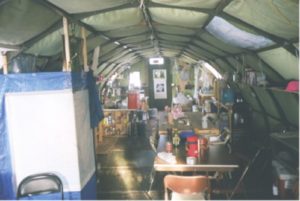

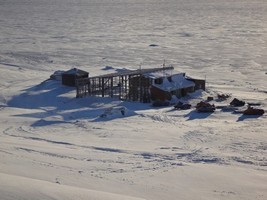 What follow, explains how the idea of carrying out a construction came up. Initially named “Casa de Botes Roberto Argentino Vallverdú” , later called “Casa de Botes Marambio” .
What follow, explains how the idea of carrying out a construction came up. Initially named “Casa de Botes Roberto Argentino Vallverdú” , later called “Casa de Botes Marambio” . Food wrapping, fishing gear and plastic waste continue to reach the Antarctic. Two new studies into how plastic debris is reaching sub-Antarctic islands are published last month of April 2020 in the journal Environment International.
Food wrapping, fishing gear and plastic waste continue to reach the Antarctic. Two new studies into how plastic debris is reaching sub-Antarctic islands are published last month of April 2020 in the journal Environment International.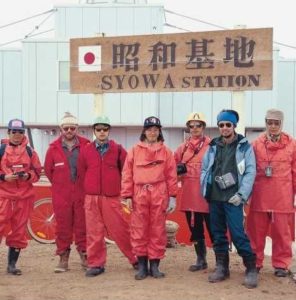 Beside Asuka Base (WAP JPN-Ø1) and Miizhuo (WAP JPN-Ø2) Showa or Syowa Station is the 3rd Japanese permanent research station in Antarctica. The fourth one is Dome Fuji (WAP JPN-Ø4).
Beside Asuka Base (WAP JPN-Ø1) and Miizhuo (WAP JPN-Ø2) Showa or Syowa Station is the 3rd Japanese permanent research station in Antarctica. The fourth one is Dome Fuji (WAP JPN-Ø4).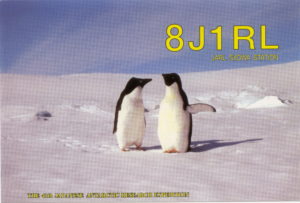
 Well, the city of Imperia by the Ligurian Riviera (Italy) is waiting you next September 11, 12 and 13 2020 at the International Naval Museum of Western Liguria .
Well, the city of Imperia by the Ligurian Riviera (Italy) is waiting you next September 11, 12 and 13 2020 at the International Naval Museum of Western Liguria . Flavio Barbiero (pic aside) lives in Italy. He is a retired Admiral in the Italian Navy who last served with NATO. In addition He is an archaeological researcher in Israel as well as the author of several books, including “The Bible without secrets” and “The secret Society of Moses”.
Flavio Barbiero (pic aside) lives in Italy. He is a retired Admiral in the Italian Navy who last served with NATO. In addition He is an archaeological researcher in Israel as well as the author of several books, including “The Bible without secrets” and “The secret Society of Moses”.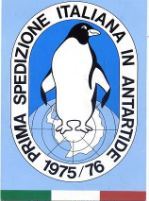 In his website, Flavio Barbiero describes the First Expedition to Antarctica by Renato Cepparo, with rare pics.
In his website, Flavio Barbiero describes the First Expedition to Antarctica by Renato Cepparo, with rare pics.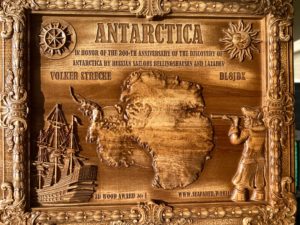 Antarctic Veteran, Dr. Volker Strecke, DL8JDX has just received the
Antarctic Veteran, Dr. Volker Strecke, DL8JDX has just received the 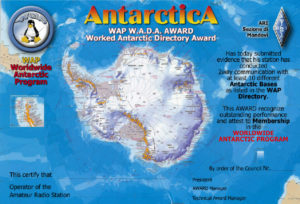 Thanks to
Thanks to  IK1GPG Max, WAP Award manager at (
IK1GPG Max, WAP Award manager at ( A sudden fire broke out at the Russian Antarctic station “Mirny”
A sudden fire broke out at the Russian Antarctic station “Mirny”  200 years is an important Anniversary and the well known at WW level: “Russian Robinson Club “ is happy for the highest participation achieved by the program in honor of the bi-centenary of discovering Antarctica.
200 years is an important Anniversary and the well known at WW level: “Russian Robinson Club “ is happy for the highest participation achieved by the program in honor of the bi-centenary of discovering Antarctica.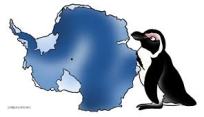 June 21 is the shortest day of the year, when in the southern hemisphere the winter begins. It is a tradition in this day, to commemorate the “
June 21 is the shortest day of the year, when in the southern hemisphere the winter begins. It is a tradition in this day, to commemorate the “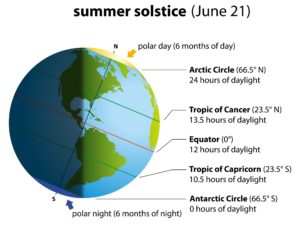 The summer solstice usually falls on June 21, and is said to mark the onset of summer in the Northern Hemisphere. It occurs when the North Pole is the nearest to the Sun. It is derived from the Latin word ‘sol‘ which means ‘sun’, and ‘sistere‘, which means ‘to stand still’ and occurs two times in a year, once in each hemisphere.
The summer solstice usually falls on June 21, and is said to mark the onset of summer in the Northern Hemisphere. It occurs when the North Pole is the nearest to the Sun. It is derived from the Latin word ‘sol‘ which means ‘sun’, and ‘sistere‘, which means ‘to stand still’ and occurs two times in a year, once in each hemisphere.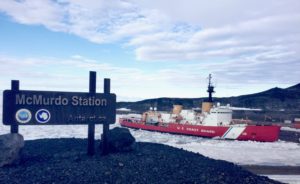
 The Bove Commission (COM-BO) is formed by a group of experts and volunteers from governmental and private institutions, with the common goal of getting more historic information on the dismantling of the Italian Giacomo Bove Station in Antarctica (WAP ITA-Ø1).
The Bove Commission (COM-BO) is formed by a group of experts and volunteers from governmental and private institutions, with the common goal of getting more historic information on the dismantling of the Italian Giacomo Bove Station in Antarctica (WAP ITA-Ø1).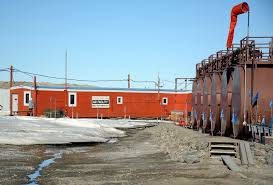 Marble Point, (
Marble Point, (
 We are talking about a place (MAVI) entering in a challenge launched by FAI (Fondo Ambiente Italiano). Since 1975, FAI – Fondo Ambiente Italiano, the National Trust for Italy, restores and takes care of special places in Italy so that present and future generations from all over the world, may enjoy a priceless legacy.
We are talking about a place (MAVI) entering in a challenge launched by FAI (Fondo Ambiente Italiano). Since 1975, FAI – Fondo Ambiente Italiano, the National Trust for Italy, restores and takes care of special places in Italy so that present and future generations from all over the world, may enjoy a priceless legacy. The “Valle Italia” Antarctic Memorial, Cèpparo-Bove (
The “Valle Italia” Antarctic Memorial, Cèpparo-Bove (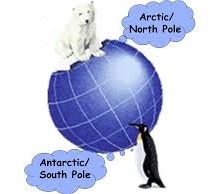 Arctic
Arctic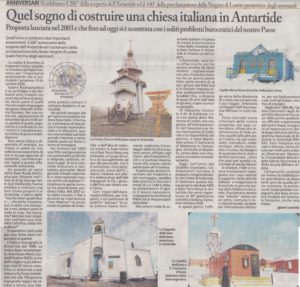 It’s an idea that comes from the heart, an idea that we have illustrated and explained in meetings, in several schools, to politicians, radio and TV, to bishops, cardinals and no less than 3 Popes in the last 13 years.
It’s an idea that comes from the heart, an idea that we have illustrated and explained in meetings, in several schools, to politicians, radio and TV, to bishops, cardinals and no less than 3 Popes in the last 13 years. When Argentina celebrates the “Dia de la Patria” our Ham friends of Ushuaia –Tierra del Fuego–
When Argentina celebrates the “Dia de la Patria” our Ham friends of Ushuaia –Tierra del Fuego– 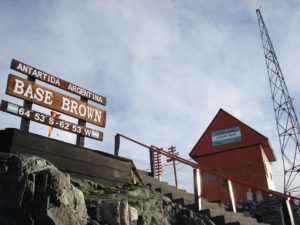 Brown Station (WAP ARG-Ø2) is an Argentine Antarctic Base and scientific research station named after Admiral William Brown, the father of the Argentine Navy.
Brown Station (WAP ARG-Ø2) is an Argentine Antarctic Base and scientific research station named after Admiral William Brown, the father of the Argentine Navy.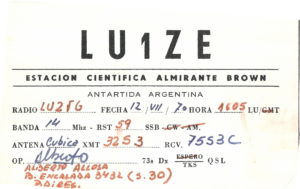 During the summer campaign of 1995–96 the Logistics Department of the Argentine National Antarctic Directorate built two new habitable modules: a laboratory and a house with amenities. In the 1999–2000 campaign the Directorate built a new main house capable of comfortably accommodating 8 people; the new building consists of 4 bedrooms, kitchen and 2 bathrooms. Brown slipped into several years of inactivity during the 2000s decade but since 2007 is occupied during the summer again. Paradise Harbor is a large sea inlet southwest of Andvord Bay protected by an arc formed by the Lemaire, Cramer and Bryde islands. Along the harbor’s deep water coast lies the small Sanavirón Peninsula, a rocky promontory crowned by a mound of almost 70 m (230 ft) high called Punta Proa, where the base facilities are located. In the area there are several beacons to help ship guidance: Punta Proa, in the homonymous place; Punta Vidt in General Ricchieri Cove; Punta Conesa, on the entrance to Puerto Leith; Hanka islet on the homonymous place in Paradise Harbor; Punta Piedras in Oscar Cove; and the lighthouse on Cramer Island.
During the summer campaign of 1995–96 the Logistics Department of the Argentine National Antarctic Directorate built two new habitable modules: a laboratory and a house with amenities. In the 1999–2000 campaign the Directorate built a new main house capable of comfortably accommodating 8 people; the new building consists of 4 bedrooms, kitchen and 2 bathrooms. Brown slipped into several years of inactivity during the 2000s decade but since 2007 is occupied during the summer again. Paradise Harbor is a large sea inlet southwest of Andvord Bay protected by an arc formed by the Lemaire, Cramer and Bryde islands. Along the harbor’s deep water coast lies the small Sanavirón Peninsula, a rocky promontory crowned by a mound of almost 70 m (230 ft) high called Punta Proa, where the base facilities are located. In the area there are several beacons to help ship guidance: Punta Proa, in the homonymous place; Punta Vidt in General Ricchieri Cove; Punta Conesa, on the entrance to Puerto Leith; Hanka islet on the homonymous place in Paradise Harbor; Punta Piedras in Oscar Cove; and the lighthouse on Cramer Island.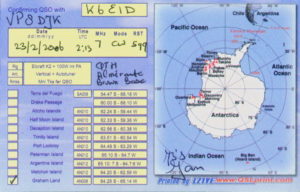 Brown is located 1,100 km (680 mi) from Ushuaia, the nearest port city. As of 2014 the base spans a total area of 1.4 ha (14,000 m2; 150,000 sq ft). It can house a maximum of 18 people. Research programs were developed for biology (zoology and botany), bacteriology, limnology, biochemistry, animal and human physiology, pathology, ecology, oceanography, meteorology, cosmic rays and ionospheric observations, environmental nuclear radiation, continental and sea ice glaciology, satellite geodesy, geology, geophysics, seismology, ozone monitoring and tide measurement.
Brown is located 1,100 km (680 mi) from Ushuaia, the nearest port city. As of 2014 the base spans a total area of 1.4 ha (14,000 m2; 150,000 sq ft). It can house a maximum of 18 people. Research programs were developed for biology (zoology and botany), bacteriology, limnology, biochemistry, animal and human physiology, pathology, ecology, oceanography, meteorology, cosmic rays and ionospheric observations, environmental nuclear radiation, continental and sea ice glaciology, satellite geodesy, geology, geophysics, seismology, ozone monitoring and tide measurement.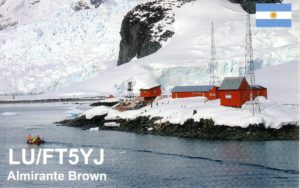 Throughout the years of research and observations at Brown, more than 100 scientific papers were published by the Argentine Antarctic Institute. Thanks to its location on the Antarctica continent along the beautiful Paradise Harbor and to its relatively mild weather, Brown Station is a popular excursion destination for tourist expedition ships visiting Antarctica. In addition to visiting gentoo penguins, tourists may climb to a viewpoint 84 m (276 ft) above the station.
Throughout the years of research and observations at Brown, more than 100 scientific papers were published by the Argentine Antarctic Institute. Thanks to its location on the Antarctica continent along the beautiful Paradise Harbor and to its relatively mild weather, Brown Station is a popular excursion destination for tourist expedition ships visiting Antarctica. In addition to visiting gentoo penguins, tourists may climb to a viewpoint 84 m (276 ft) above the station. It’s been 180 years since Charles Wilkes (April 3, 1798 – February 8, 1877) an American naval officer, ship’s captain, and explorer led the United States Exploring Expedition, 1838-1842. He voyaged to the Antarctic continent and his journey has never been more relevant!
It’s been 180 years since Charles Wilkes (April 3, 1798 – February 8, 1877) an American naval officer, ship’s captain, and explorer led the United States Exploring Expedition, 1838-1842. He voyaged to the Antarctic continent and his journey has never been more relevant!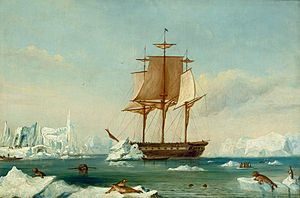 Amundsen might have been the first man to reach the South Pole, in 1911, but the discovery of the Antarctic continent occurred several generations earlier. In January 1840, when Wilkes was commander of the United States Exploring Expedition, he charted 1500 miles of the east Antarctic coastline in his flagship U.S.S. Vincennes (picure on the right, shows the 19th-century painting, based on a sketch by Lieutenant Charles Wilkes, USN, depicting USS Vincennes in Disappointment Bay, Antarctica, circa January–February 1840).
Amundsen might have been the first man to reach the South Pole, in 1911, but the discovery of the Antarctic continent occurred several generations earlier. In January 1840, when Wilkes was commander of the United States Exploring Expedition, he charted 1500 miles of the east Antarctic coastline in his flagship U.S.S. Vincennes (picure on the right, shows the 19th-century painting, based on a sketch by Lieutenant Charles Wilkes, USN, depicting USS Vincennes in Disappointment Bay, Antarctica, circa January–February 1840).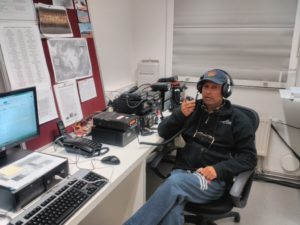 We remind our friend Ham radio Bhagwati Prasad Semwal, VU3BPZ (on the pic aside while at Maitri Base) when reading the article below, which gives our readers an idea on what means a Scientific campaign in Antarctica. Not only a pleasure of a selfy with penguins, not a vacation in a paradise but study, scientific projects, researches and experiments, hard life away from the normal activities at home.
We remind our friend Ham radio Bhagwati Prasad Semwal, VU3BPZ (on the pic aside while at Maitri Base) when reading the article below, which gives our readers an idea on what means a Scientific campaign in Antarctica. Not only a pleasure of a selfy with penguins, not a vacation in a paradise but study, scientific projects, researches and experiments, hard life away from the normal activities at home.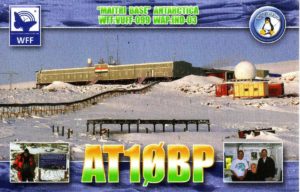 India’s Bharati Station in Antarctica. The continent is home to around 70 active research bases belonging to various countries. These bases house more than 4,000 people during the summer and around 1,000 people in winter. They spend an entire year in isolation, conducting research projects on the icy continent.
India’s Bharati Station in Antarctica. The continent is home to around 70 active research bases belonging to various countries. These bases house more than 4,000 people during the summer and around 1,000 people in winter. They spend an entire year in isolation, conducting research projects on the icy continent. This year, the winter team has 23 members deployed at the Bharati station. It is my responsibility to conduct regular health check-ups to ensure the physical and mental wellbeing of my team mates.
This year, the winter team has 23 members deployed at the Bharati station. It is my responsibility to conduct regular health check-ups to ensure the physical and mental wellbeing of my team mates. Amateur radio use in the UK has seen a “significant” rise during the coronavirus lockdown as people seek new ways of staying connected. The national body that represents users – the Radio Society of Great Britain (RSGB) – has said many people who formerly enjoyed the hobby are also returning to it.
Amateur radio use in the UK has seen a “significant” rise during the coronavirus lockdown as people seek new ways of staying connected. The national body that represents users – the Radio Society of Great Britain (RSGB) – has said many people who formerly enjoyed the hobby are also returning to it.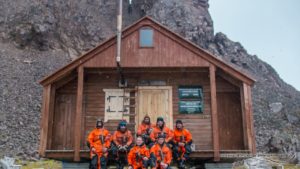 Located on ASPA 128, Demay refuge (wood hut) 62°13’ South, 58°26’30” West, is situated on a flat marine gravel terrace in Paradise Cove between Demay Point and Uchatka Point. The refuge can be reached both by Zodiac and by foot.
Located on ASPA 128, Demay refuge (wood hut) 62°13’ South, 58°26’30” West, is situated on a flat marine gravel terrace in Paradise Cove between Demay Point and Uchatka Point. The refuge can be reached both by Zodiac and by foot.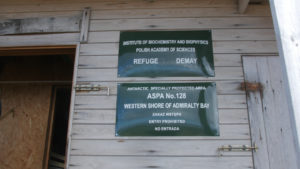 Their memories are preserved in the cottage guest book. The refuge contains two bunk beds, gas cooker, stove and even a shower. There is a VHF radio available with antenna on the rocks above the refuge. It is perfect for hiding from the cold, wind, blizzard and heavy rain. Those who stayed in the Paradise overnight can confirm that few earthy pleasures compare to a dawn on the veranda with a warm cup of tea in hands and a view over a calm horizon decorated with icebergs, waves breaking against the rocks of Demay Head, sleepy elephant seals and playful furseals.
Their memories are preserved in the cottage guest book. The refuge contains two bunk beds, gas cooker, stove and even a shower. There is a VHF radio available with antenna on the rocks above the refuge. It is perfect for hiding from the cold, wind, blizzard and heavy rain. Those who stayed in the Paradise overnight can confirm that few earthy pleasures compare to a dawn on the veranda with a warm cup of tea in hands and a view over a calm horizon decorated with icebergs, waves breaking against the rocks of Demay Head, sleepy elephant seals and playful furseals.